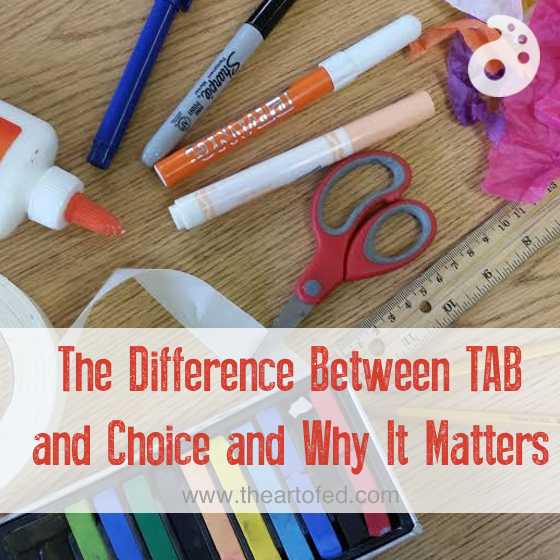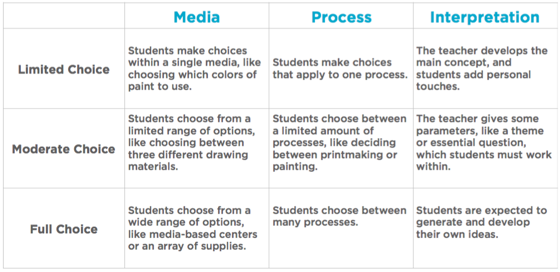TAB and choice are the same thing, right? Not exactly. While many educators use these terms interchangeably, TAB and choice have key differences. However, it’s important to understand their relationship because they are deeply connected. Choice is present in all classrooms, while TAB is utilized in classrooms designed for choice-based learning and has more in common with other teaching styles than some might think.

So, What is Choice?
Choice refers to the act of providing options. When more choice is included in a learning experience, students become more responsible for the creative process.
All teachers, regardless of teaching style, incorporate choice in the following 3 ways.

1. Choice of Materials
This choice might range from making choices within a single medium, such as which colors of paint to use, to making choices between mediums. For example, in a drawing lesson, students could be given a choice between graphite, charcoal or pen. Or, the level of choice could be increased by opening selection to all two-dimensional materials.
2. Choice in Process
Choice in process involves students deciding how to apply materials. In a painting lesson, this could look like picking between making a gradient for the background or trying sponge painting. It could also mean allowing students to pick any kind of paint application they know or experimenting to find a new one. Choice with process can also involve picking between a selection of processes, such as addressing a theme through drawing, printmaking, or painting.
3. Choice in Interpretation
This often looks like asking students to interpret a topic or theme. In an elementary classroom, students might all make art about a topic like “Family” while older students may work with more complicated themes. Also, learners can be asked to develop their own themes or select their own topics.
Some teachers offer greater amounts of choice, others offer smaller, but some level of choice is present in all classrooms. Take a peek at the Choice Spectrum to gain solid ideas to incorporate even more choices in your classroom.
Sometimes choice is offered in only one of the three areas listed above, while other times it’s present in all areas.
So, What About TAB?
A Little Background
Teaching for Artistic Behavior is, in the words of TAB co-founder Diane Jaquith, “a philosophy that believes in the child as the artist.” Originally started in elementary classrooms, lessons typically begin with a short demonstration followed by students working on self-directed projects in media-based centers. In a TAB lesson, students typically make all choices with materials, process, and interpretation. They also often decide how long to spend with projects, form collaborative groups organically, and make decisions about displaying work.
How TAB Teachers Offer Choice
Choice is utilized in TAB classrooms as a method of teaching for artistic behaviors like planning, problem-solving, and generating ideas. Traditionally, TAB teachers offer choice in all three areas, most of the time, to maximize creative thinking.
However, many teachers modify the level of choice by setting limits. For example, they might require that all students try a specific process or use a required number of different media within a specific time frame. Many TAB teachers, especially at the high school level, limit choice in interpretation by setting themes or topics that students are expected to address. TAB teachers may limit choice to focus in on other aspects of the curriculum. For example, when teaching a new media, a teacher might require that all students try it but still leave process open to student’s choice to facilitate learning through experimentation.
However TAB teachers offer choice, it is with the overarching intent to teach students to think like artists by making independent decisions regarding the majority of their work. TAB teachers offer choice to teach for creative decision making by modeling curriculum around what working artists do and know.
The Takeaway
Choice is a teaching method that consists of providing students with options in three areas: media, process, and interpretation. TAB is a pedagogy that is focused on supporting divergent thinking and teaching for creativity. Providing choice to students is one method that TAB teachers use to do this, but all teachers utilize choice in their classrooms to some degree. It’s easy to confuse the two because they are connected. However, just because a teacher offers choice, does not mean they have a TAB classroom. In the same vein, just because a teacher runs a TAB classroom, does not mean their students have no limitations.
How do you offer choice to students in your classroom?
Within which category is it easiest for you to offer choice–media, process or interpretation?
Magazine articles and podcasts are opinions of professional education contributors and do not necessarily represent the position of the Art of Education University (AOEU) or its academic offerings. Contributors use terms in the way they are most often talked about in the scope of their educational experiences.




